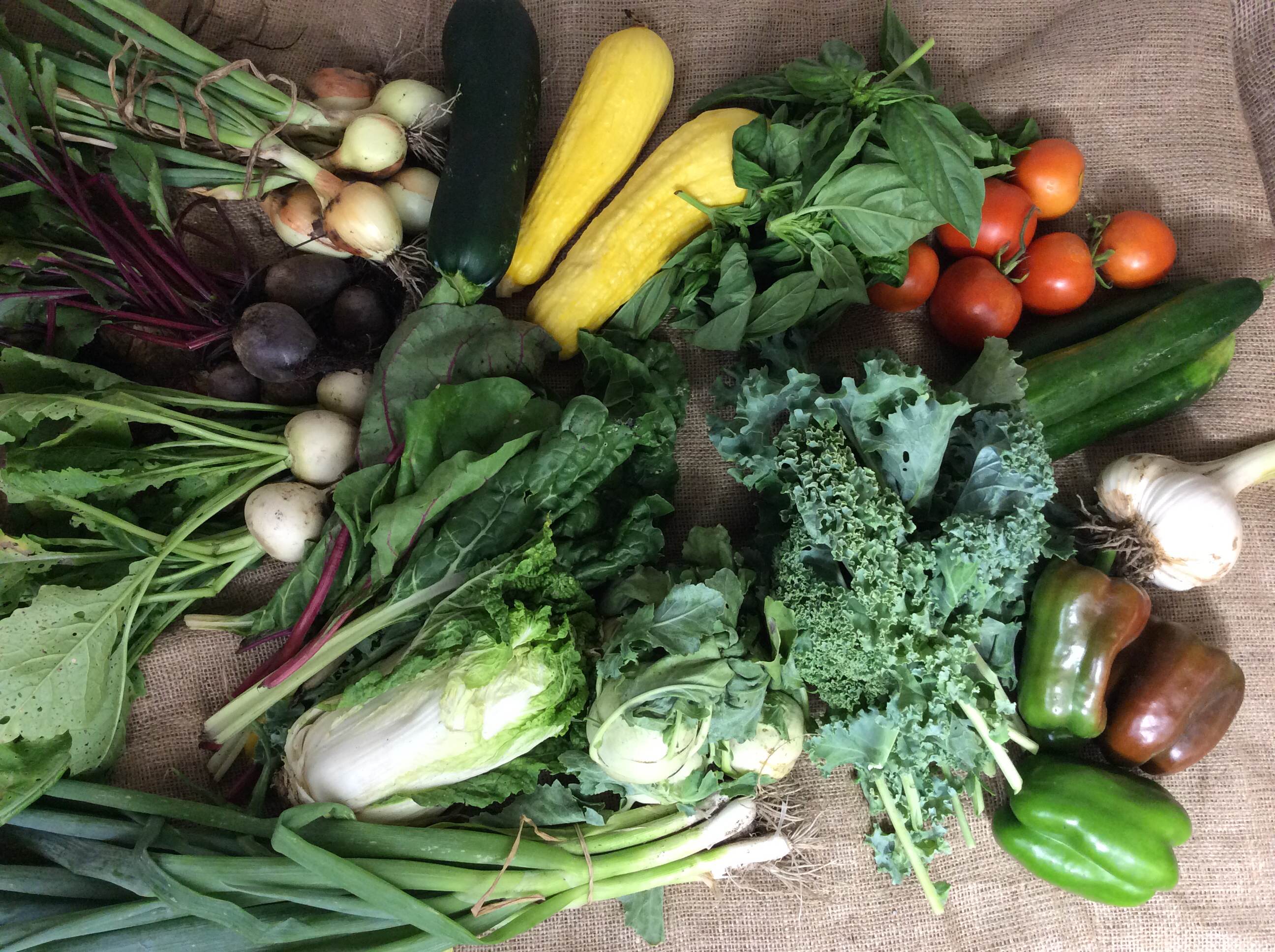Not yet a member? You can still sign up and learn more here!
Another week of great variety for the 2016 Redfearn Farm CSA Season! This week we are only having 2 farm selected items, and having an additional choice item for all shares (therefore Basic Shares will get 3 choice items and Premium Shares will get 6 items this week!) The items available for Week 7 of the CSA season are: Farm Selected Items (shown on the top left of the photo):Spring Onions and Zucchini/ Yellow squash and for the Choice Items (roughly top to bottom, L to R):Basil, Tomatoes, Cucumbers, Beets, Salad Turnips, Swiss Chard, Napa Cabbage, Kohlrabi, Green Onions (on the bottom), Kale, Sweet Bell Peppers, Fresh Garlic and (and not pictured, Radishes and Bok Choy).
Zucchini/ Yellow squash (Farm selected Item, 3 zucchini/ squash mix or match, will count as one item): store in plastic bag in refrigerator. Zucchini is great raw or sautéed, grilled, or baked into zucchini bread (my kids favorite way to eat zucchini!). Raw zucchini/ squash makes a fresh, flavorful salad as in this: Summer Squash Salad with Lemon Citronette. Zucchini (sliced and broiled or pan fried) can take the place of pasta in lasagna. If you want more ideas, you can try Baked Zucchini Fries, Squash baked eggs or Zucchini Fritters or Chocolate Zucchini Bread or these main dishes Baked Penne with Roasted Vegetables (this is a great recipe to use a lot of vegetables, including zucchini, yellow squash, eggplant, peppers, onions and garlic), Cheesy Zucchini Casserole (which we make with shredded sharp cheddar, instead of Velvetta). Here’s a couple other zucchini recipes, recommended by CSA members: Curried Zucchini Soup, Zucchini Tots, Sauteed Zucchini with Cherry Tomatoes (don’t overcook the zucchini!), and Zucchini Chocolate Rum Cake. To preserve: Zucchini or Yellow squash can be shredded and frozen to use in Zucchini bread recipes.
Spring Onions (Farm selected Item):These uncured onions with greens are best used quickly and don’t store as well as later (cured) onions. Here is some inspiration if you need more ideas of how to use onions: 50 Onion Recipes.
CHOICES (Basic shares can choose 3, Premium Shares can choose 6!):
Basil (Choice Item): To keep basil fresh, trim the stems and place them in a glass or jar of water, just like cut flowers. Loosely cover it with a plastic bag and leave it on the counter. Do not refrigerate or basil will darken.Here are some ways to use basil: top sliced tomatoes with chopped basil and olive oil, make Pesto, or use to season italian dishes. If you need to preserve basil leaves; it can be pureed with olive oil and frozen (in ice cube trays or small plastic bags. For more detailed instructions for preserving basil, click here. If you need more ideas for how to use basil, check out this link: 34 Basil recipes to carry you through summer.
Tomatoes (Choice Item): store at room temperature.
Cucumbers (Choice Item): store in plastic bag in refrigerator. Pair with tomatoes in an Israeli Salad, Cucumber, Tomato, and Avocado Salad, Panzanella Salad. Cucumbers are the base for the Mediterranean sauce, Tzatziki. Cold Cucumber Soup is also a refreshing way to use cucumbers.
Kale (Choice Item): store in plastic bag in refrigerator. Kale can be eaten raw as in Kale Salad and in green smoothies or cooked (sautéed in olive oil or coconut oil), Kale Pesto (Pesto can be frozen). Try this Zuppa Tuscana soup (I usually add a can of tomatoes to this soup and sometimes kidney beans).
Radishes (Choice item): Store in plastic bag in refrigerator. Crisp radishes in ice water. Sliced radishes add great flavor to salads. You can also just eat them straight with butter and a sprinkle of salt. There are many variations of radish salads, here are a couple: Radish and Mint Salad , Smitten Kitchen’s chopped salad, and Radish, Cucumber and Orange Salad. Radishes are milder when roasted or cooked. I cut radishes in half and toss with a little olive oil, salt and pepper and roast at 425F until tender crisp (they can be roasted alongside sweet potatoes or carrots for a nice flavor and color combination).
Beets (Choice item): Store in plastic bag in refrigerator. Both the roots and leaves are great. Here is a compilation of recipes: Huffington Post Beet Recipes (we have enjoyed recipe #4, French Peasant Beets). Beets make a great addition to salad, as in this Roasted Beet Salad with Pea Shoots and Beet salad with Goat Cheese .
Napa Cabbage (Choice Item): store in fridge in a plastic bag. Our favorite way to prepare is to simply chop the napa cabbage into uniform sized pieces (I prefer about 1 inch pieces), lightly toss with olive oil and salt and pepper and roast in a single layer at 425F until the cabbage in tender crisp and some of the edges are slightly browned. Can be stir fried, roasted, made into salad or made into Kimchi (a Korean speciality, spicy fermented cabbage). Kimchi is one of the best ways to preserve cabbage.
Kohlrabi (Choice Item): Both the leaves and the bulbous stem (the round part) are edible. The bulbous part can last for a couple weeks in the fridge, but the greens should be use within a couple days, both should be stored in plastic bags in the refrigerator . The bulb should be peeled by cutting off a thin slice on the top and bottom of the bulb and using a paring knife to cut the skin off the kohlrabi bulb.Here is a link with recipes using the kohlrabi bulb and greens, including one of our favorites, the kohlrabi patties: Kohlrabi Recipes. A simple preparation of kohlrabi is Butter- braised Kohlrabi: Peel kohlrabi, and thinly slice (1/8 to 1/4 inch thick) and cook in a skillet with butter and olive oil and salt and pepper, add about 1/2 cup of chicken broth, cover the skillet and cook, stirring occasionally, until tender. Optional: Cream can be added at the end. Eaten raw, kohlrabi is fresh, crisp, and the ideal ingredient for a summer slaw, such as this Kohlrabi and Carrot slaw or in this excellent Kohlrabi- Apple Salad!
Salad turnips (Choice Item): Salad turnips are crunchy, sweet and only slightly peppery. Storage Tips: The leaves cause moisture loss during storage, so it is best to remove tops and store the root and greens separately in the refrigerator. Preparation and Cooking: Enjoy salad turnips as you would radishes in fresh salads. Salad turnips can also be thinly sliced and sauteed, or pickled with other vegetables. Other detailed recipes are Salad turnip and radish sandwiches and Turnip and Apple Salad, Roasted turnips, Glazed turnips and more.
Bok Choy (Choice Item):Store in plastic bag in the refrigerator. Here is a basic bok choy recipe with great instructions: Stir-fried Bok Choy . Cooked (leftover) Bok Choy can be added to fried rice. Bok Choy can also be cooked and used inside egg rolls (I just followed the instructions on the back of the package of egg roll wrappers). Bok Choy can also be grilled, as in this Grilled Baby Bok Choy with Miso butter! Bok choy can be sliced and added to soups during the last few minutes of cooking.If you would rather eat bok choy raw; it can be chopped and dressed with an asian- style dressing: Bok Choy Salad
Green Onions (Choice Item): Store in plastic bag in the refrigerator. Use in lots of Chinese/ other asian recipes (General Tso’s chicken and Korean beef are two Redfearn favorites) chicken salad, egg salad, salad dressing to name a few.
Sweet Bell Peppers (Choice Item): Store in plastic bag, in refrigerator. Meal idea: sauté sliced candy onions and sweet pepper for a tasty Philly Cheese Sandwich or Fajitas. Stuffed peppers are also a favorite main dish at our house; zucchini/ yellow squash can also be stuffed using the same recipe. Sweet peppers can easily be preserved by freezing and they can be frozen raw, without blanching first. Cut peppers into the desired size: diced for adding to winter casseroles, soups or sauces; sliced for fajitas; or halved (or the tops cut off) to be used for stuffed peppers (also, after freezing there is no need to parboil peppers before stuffing) and freeze in freezer bags.
Swiss Chard (Choice Item): Store in plastic bag in the refrigerator. The swiss chard leaves have a very mild flavor similar to spinach. Both the stem and the leaves can be eaten and I usually use both together; chop the stems like you would celery and begin cooking the stems before adding the greens. This is a basic swiss chard recipe: Swiss Chard with Balsamic Vinegar. Our family really likes this Swiss Chard, Sausage, White bean casserole ( I use the stems and leaves of the chard). This Swiss Chard and Ricotta Crostata is a wonderful recipe, and one of my all-time favorites. Swiss chard leaves can be used just like spinach in my Crustless Spinach Quiche recipe. Swiss chard can also be used in curry, as in these: Saag Paneer (I have used a bunch of swiss chard in place of spinach in this recipe; I washed, then coarsely chopped the chard stems and leaves, and then processed the swiss chard while raw in a food processor) and Curried Lentils and Sweet Potatoes.

